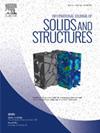Inverse design of tubular energy absorbers formed from the least-symmetric crystallographic DDC surface
IF 3.4
3区 工程技术
Q1 MECHANICS
International Journal of Solids and Structures
Pub Date : 2025-06-07
DOI:10.1016/j.ijsolstr.2025.113508
引用次数: 0
Abstract
Thin-walled origami tubes are distinguished by their superior energy-absorption capacity during axial crushing, a property largely attributed to their intricate crease patterns. To develop optimized tubes for enhanced energy-absorption performance, we propose a strategy for the inverse design of tubular energy absorbers formed from the least-symmetric crystallographic developable double-corrugation (LSDDC) surface. To this end, first, the phase space of all flat-foldable configurations is systematically mapped based on the kinematics of the LSDDC surface. To account for the various transformations of unit fragments into origami structures, constraint equations are derived based on the inherent geometry of enclosed structures. The solution space for various configurations is delineated using both traversal techniques and the particle swarm optimization (PSO) method. A comparative performance analysis is conducted among the proposed LSDDC tube and two conventional tubes: the isosceles trapezoidal origami bellow (ITOB) tube and the arc-Miura-ori (AMO) tube. Both the AMO and LSDDC tubes demonstrate superior energy-absorption performance compared to the ITOB tube. The choice between the AMO and LSDDC tubes can be made based on specific application requirements. While the AMO tube exhibits a slightly higher mean crushing force than the LSDDC tube, the LSDDC tube possesses a substantially higher crushing force efficiency than the AMO tube. Finally, we present the inverse design process, which identifies the optimal input parameters for energy absorption. This framework enables the transformation of diverse crease patterns into various origami structures with enhanced energy absorption, broadening their applicability and revitalizing the potential of origami-inspired designs.

由最小对称晶体DDC表面形成的管状吸能器的反设计
薄壁折纸管的特点是其优越的能量吸收能力在轴向破碎,这一性质很大程度上归因于其复杂的折痕模式。为了开发具有增强吸能性能的优化管,我们提出了一种由最小对称晶体可展双波纹(LSDDC)表面形成的管状吸能器的反设计策略。为此,首先,基于LSDDC曲面的运动学,系统地映射了所有可平折构型的相空间。为了考虑单元碎片到折纸结构的各种变换,基于封闭结构的固有几何推导了约束方程。利用遍历技术和粒子群优化(PSO)方法描述了各种构型的解空间。将所提出的LSDDC管与两种常规管:等腰梯形折纸波纹管(ITOB)和弧形三浦里管(AMO)进行了性能对比分析。与ITOB管相比,AMO管和LSDDC管均表现出优越的吸能性能。AMO和LSDDC管之间的选择可以根据具体的应用要求。AMO管的平均破碎力略高于LSDDC管,而LSDDC管的破碎力效率明显高于AMO管。最后,我们提出了逆向设计过程,确定了能量吸收的最佳输入参数。这个框架使不同的折痕模式转化为各种折纸结构,增强了能量吸收,扩大了它们的适用性,并重振了折纸设计的潜力。
本文章由计算机程序翻译,如有差异,请以英文原文为准。
求助全文
约1分钟内获得全文
求助全文
来源期刊
CiteScore
6.70
自引率
8.30%
发文量
405
审稿时长
70 days
期刊介绍:
The International Journal of Solids and Structures has as its objective the publication and dissemination of original research in Mechanics of Solids and Structures as a field of Applied Science and Engineering. It fosters thus the exchange of ideas among workers in different parts of the world and also among workers who emphasize different aspects of the foundations and applications of the field.
Standing as it does at the cross-roads of Materials Science, Life Sciences, Mathematics, Physics and Engineering Design, the Mechanics of Solids and Structures is experiencing considerable growth as a result of recent technological advances. The Journal, by providing an international medium of communication, is encouraging this growth and is encompassing all aspects of the field from the more classical problems of structural analysis to mechanics of solids continually interacting with other media and including fracture, flow, wave propagation, heat transfer, thermal effects in solids, optimum design methods, model analysis, structural topology and numerical techniques. Interest extends to both inorganic and organic solids and structures.

 求助内容:
求助内容: 应助结果提醒方式:
应助结果提醒方式:


